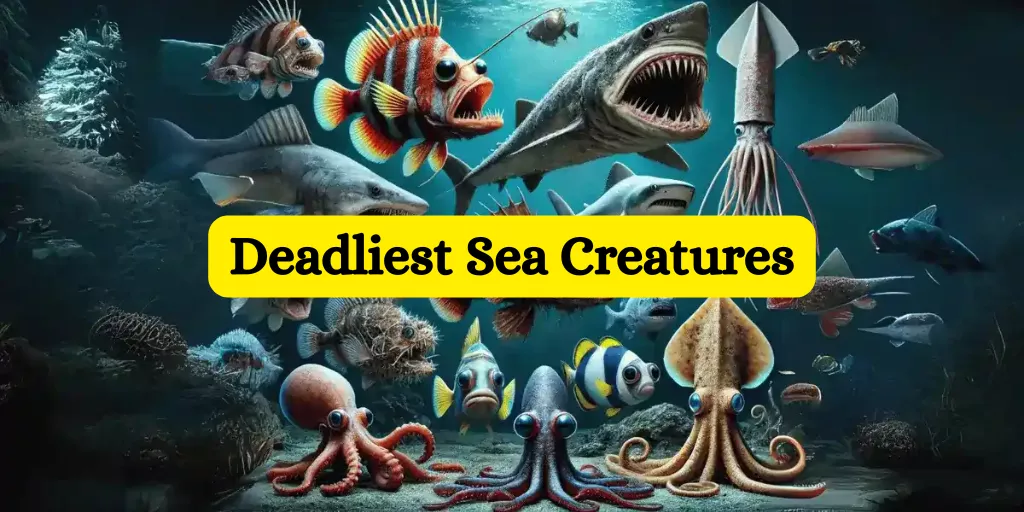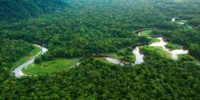Deadliest Sea Creatures: Top Marine Killers Explained” illustrates that, while the ocean is huge, gorgeous, and full of mystery, its most hazardous creatures are sometimes those we least expect. Rather than sharks or whales, many of the most dangerous water species are small, inconspicuous, and attack only when threatened or mistakenly provoked. These concealed stingers, biters, and venomous creatures make up some of the most dangerous marine animals on the planet.
Ocean’s Silent Killers: 11 of the Deadliest Sea Creatures You Should Know About
1. Who Are the Ocean’s Deadliest?
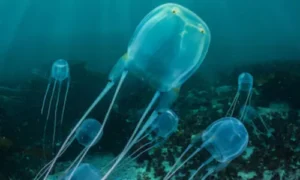
The box jellyfish is one of the ocean’s most venomous organisms. Its tentacles, which may grow up to 3 meters long, are filled with poisons that assault the heart, nervous system, and even skin cells.
For unlucky swimmers who make contact, death might occur within minutes. Many victims experience shock, drowning, or heart failure before reaching shore.
2. Beaked sea snake
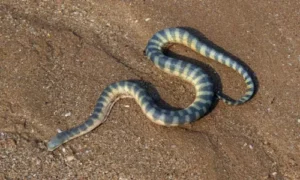
The beaked sea snake is the most hazardous of the approximately 64 species of sea snakes. Its toxin can cause paralysis, including of the diaphragm, which can result in respiratory failure. It spreads venom through tiny fangs.
Fortunately, sea snakes are generally non-aggressive and avoid people, so attacks are uncommon. The most hazardous encounters occur when fishermen unintentionally catch snakes in nets.
3. Cone snail

Some cone snails are among the fiercest predators in the ocean, so don’t be fooled by their elaborate shells. They use a tooth resembling a harpoon to attack, injecting a powerful venom that paralyses prey almost immediately.
Human fatalities are uncommon, but about 30 have been reported. Handling any cone snail or shell discovered at the beach is dangerous because there is no known antivenom.
4. Stonefish

Stonefish are masters of disguise, blending in seamlessly with rocks, coral reefs, and the seafloor. This camouflage allows them to ambush prey while simultaneously posing a significant hazard to unsuspecting swimmers.
When startled, the fish raises dorsal spines, delivering poison. Stings can cause terrible pain, fast swelling, and, in severe cases, necrosis or death if not treated immediately. However, fatalities are uncommon when prompt treatment (heat immersion plus antivenom) is available.
5. Blue‑ringed octopus
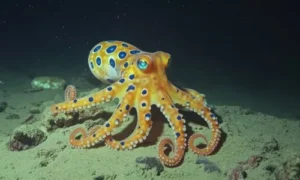
The blue-ringed octopus is tiny but incredibly hazardous. Its venom contains tetrodotoxin, which is potent enough to kill a human in minutes.
Its bite can be almost painless, so victims may not realise they’ve been envenomated until paralysis and respiratory collapse occur. There is no antidote.
6. Pufferfish
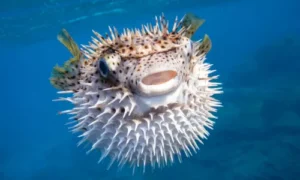
Pufferfish are dangerous to eat, not because of how they look. They have fatal neurotoxins in their organs, especially the skin, eyes, ovaries, and liver.
Only chefs with specialised licenses are permitted to prepare pufferfish, also referred to as “fugu,” in Japan. When used improperly or at home, it has resulted in deadly poisonings.
7. Stingray
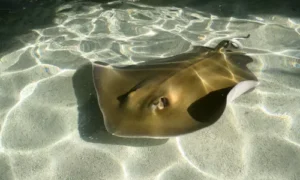
In general, stingrays are calm creatures that glide through the water when buried in the seabed. However, they can retaliate with poisonous barbs on their tails if they are unintentionally trodden upon or frightened.
Divers and swimmers are advised to shuffle their feet when going across sandy seabeds to avoid agitating a stingray, as assaults are uncommon but can result in serious injury.
8. Saltwater crocodile
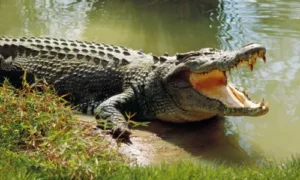
The largest living reptile is the saltwater crocodile. With the strongest bite in the animal kingdom and a maximum length of 7 m and a weight of 1,000 kg, it is an incredibly dangerous predator.
In brackish coastal waters, they are extremely territorial, and although attacks on humans are uncommon compared to popular belief, they nevertheless pose a serious threat in the areas they call home.
9. Great white shark

The great white shark is possibly the most well-known of all lethal aquatic animals. They are strong predators, with bodies up to 6 metres long and weighing up to 1,800 kg, as well as razor-sharp teeth built for shredding.
According to data, 351 of the 949 documented unprovoked shark attacks on humans worldwide were carried out by great white sharks, with 59 of them fatal. However, such assaults are relatively unusual in comparison to the number of individuals who swim in the water.
10. Lionfish
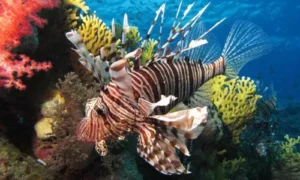
The lionfish may be lovely, but it has venomous spines beneath its fins that may deliver a devastating sting. In rare situations, this might result in significant symptoms such as temporary paralysis, breathing difficulty, and nausea.
While lionfish rarely attack humans, divers or aquarium handlers frequently get injuries when they get too close. As they spread across the Indo-Pacific, it becomes increasingly necessary to be aware of their risk.
11. Portuguese man-of-war

The Portuguese man of war may appear to be a single creature, but it is actually a collection of thousands of organisms working together. Its lengthy, floating tentacles deliver stinging stings that can immobilise victims.
While a sting from this species is unlikely to be fatal to humans, it can cause extreme pain, prompting beach closures after detecting even one. Tens of thousands of people are stung each year in locations where it floats ashore.
Why So Dangerous—and Why It Matters
Many of the creatures on this list are not large predators ready to hunt humans. Instead, their danger stems from venom, concealment, or defence systems – and most human contacts are unintentional.
This means that, while the water is beautiful, it must also be respected. Whether you’re a swimmer, snorkeler, diver, or beachgoer, a moment of carelessness can result in disastrous or even fatal consequences.
Always be aware, never assume the water is fully safe, and appreciate aquatic life, even those you can’t see.
Safety Tips for Getting Near the Ocean
- Avoid touching or picking up seashells, especially cone snail shells. Even a seemingly empty shell might be hazardous.
- When walking on seabeds or shallow waters, shuffle your steps. This alerts hidden species such as stonefish or stingrays, preventing them from mistaking you for prey.
- Pay attention to beach warnings and avoid swimming during the jellyfish and man-of-war season.
- Do not try to catch or handle marine creatures, even if they appear harmless or attractive.
Conclusion
Although the ocean appears serene and many of its inhabitants are lovely, there is a dangerous world beneath the surface. We are reminded that power isn’t always determined by size by animals like the cone snail, box jellyfish, and blue-ringed octopus.
We may admire the sea’s wonder without undervaluing its dangers if we are aware of these silent murderers and treat it with respect.


